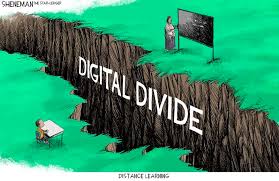1. What do you think about the framework outlined in Sieck et.al.? What do you think are the most important elements in Figure 1, which is located on the second page of the article?
I think that the model outlined by Sieck et al. (2021) is practical and proactive; it redefines digital access as a super social determinant of health, and it recognizes that people can’t fully access other key determinants, such as education, employment, and healthcare, without digital literacy, connectivity, adequate devices, and support. The most essential elements in Figure 1 are digital skills and connectivity, because they are the foundation for all other areas of well-being. Without having the ability and access to use technology effectively or access reliable internet, people cannot access critical systems such as telehealth, online job applications, or virtual learning.
- Do you think this is a good framework to describe the impact of the digital divide? Why?
This framework describes the impact of the digital divide, going beyond simply stating that people lack internet access to show how digital inequality can create health, social, and economic disparities. By integrating digital access into the broader social determinants model, the authors successfully argue that digital inclusion must be part of public health and policy planning.
- Sanders & Scanlon discuss the digital divide in some length. Describing why it is a social justice issue (through page 135). Which of the areas they discuss was the most impactful for you? Were their arguments persuasive and why? Do you think they defined the problem correctly, and why or why not?
In my opinion, the most impactful part of Sanders and Scanlon’s discussion was their tying the digital divide to human rights and civic participation. They argued that lacking internet access isn’t just inconvenient, but it’s also a form of exclusion that limits people’s voices, opportunities, and ability to engage in democracy. Their explanation of digital redlining, where marginalized communities are excluded from affordable broadband access, was very convincing. I believe they defined the problem correctly, because they addressed both the structural causes: privatization and inequality, but also the human impact: social isolation, and economic disadvantage.
- Sanders & Scanlon then go on to describe a strategy to advocate for change regarding the digital divide. Which of those strategies did you find most promising and why? What suggestions do you think weren’t realistic or possible, and why?
The most promising strategies were public broadband expansion and community-level advocacy, such as creating municipal networks modeled on Chattanooga, focusing on long-term, sustainable access, showing how public ownership can prevent exploitation by large corporations. Strategies like expecting federal programs alone or FCC subsidies seem less realistic because they often have limited funding, low public awareness, and bureaucratic barriers, which make them insufficient on their own.
- Finally, Craig et. al (2021) take the idea of technology access and discuss it in relation to a specific client population using a specific tool. What elements of their approach do you think were most effective and why? Can you see any connections between this specific example and the problems or concerns that are raised in the other two examples?
Craig et al. (2021) show how digital access and telehealth can be life-changing for marginalized youth, particularly LGBTQ+ people who may not have safe in-person support. The AFFIRM program’s structure, with its emphasis on inclusion, confidentiality, and emotional safety in virtual settings, was one of its strongest elements. The connection to the other two articles is clear; without digital inclusion and literacy, interventions like AFFIRM could not exist or reach those most in need.
All those articles show that digital access isn’t only about convenience, but it can also determine who receives mental health support and who might not, underlining the idea that technology equity is fundamental to both health and social justice.

Hello! Your response clearly demonstrates a deep understanding of how digital access intersects with social justice and public health. You effectively connect each article, showing how digital inequality impacts every aspect of well-being, from healthcare to civiv participation. I especially like how you highlighted structural issues like digital redlining and tied them to real-world policy solutions such as municipal broadband.
Hello! Great job on you post! I like how you stated that digital divide is form of exclusion; that limits people’s voices, opportunities, and ability to engage in democracy. These are examples of how systemic discrimination exist.